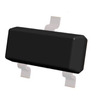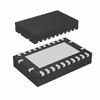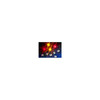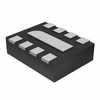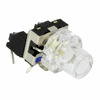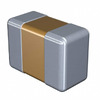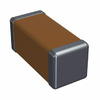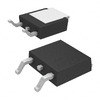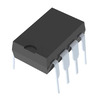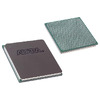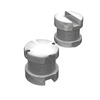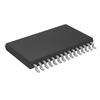NRF24L01 Transceiver: Pinout, Equivalents, and Datasheet
The NRF24L01 transceiver is a highly efficient, low-power wireless communication device that works in the 2.4GHz range. This article goes over its many features and specifications, showing how versatile it is for different uses, from home electronics to industrial automation. We look at its small size and strong performance to explain how it fits into modern wireless systems, helping improve connections and support new technology in various fields.Catalog

What is the NRF24L01 Transceiver?
The NRF24L01 is a powerful 2.4GHz transceiver that plays a role in building low-power wireless systems. It uses Enhanced ShockBurst™ technology to improve performance and works within the 2.400 to 2.4835 GHz ISM band. Its design aims to reduce the need for extra components when connected to a microcontroller. The SPI interface controls its setup and functions, allowing easy access to various settings.
The durable design of the NRF24L01 makes it suitable for many uses, from home automation to industrial data transfer. The SPI interface also makes it easy to integrate into complex projects without needing complicated hardware. By accessing multiple settings, you can adjust the transceiver to meet specific needs, giving them flexibility in design. Energy efficiency is a key feature of the NRF24L01, which is especially useful for battery-powered devices. The Enhanced ShockBurst™ technology helps manage data effectively while saving power. Many smart system designs focus on extending battery life and reducing power usage, and the NRF24L01 supports these goals well.
NRF24L01 Pin Configuration

NRF24L01 Symbol, Footprint, and CAD Model
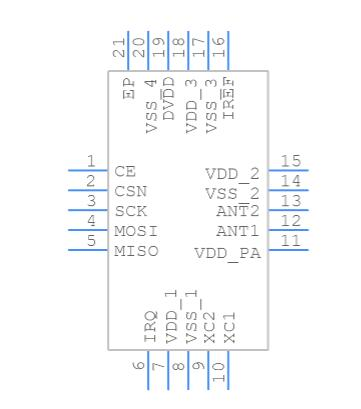
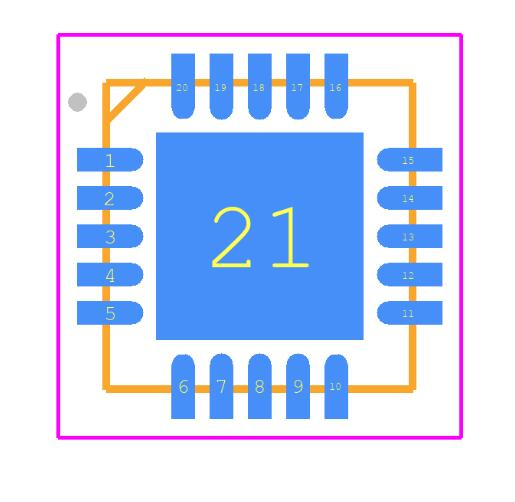

Features of the NRF24L01
The NRF24L01 transceiver is a strong, flexible choice for worldwide ISM band communication, with data rates up to 2Mbps. It's designed to save energy, making it ideal for battery-powered devices. It uses only 11.3mA at 0dBm during transmission and just 900nA in standby mode, which is a big advantage in power-saving applications. With a wide voltage range from 1.9 to 3.6V and built-in voltage regulation, it works well with different power sources, making it useful for many purposes.
The transceiver can handle multiple data streams at once, a valuable feature for settings that require reliable data management. Its automated packet handling improves system reliability and makes setup easier, especially important in industrial environments where speed and reliability are required. Many transceivers aim to balance power and performance, the NRF24L01 stands out for its excellent efficiency and reliability. This makes it an excellent option for those looking to improve data transmission while carefully managing energy use.
Block Diagram of the NRF24L01

NRF24L01 Technical Specifications
|
Type |
Parameter |
|
Factory Lead Time |
20 Weeks |
|
Package / Case |
20-VQFN Exposed Pad |
|
Number of Pins |
20 |
|
Packaging |
Tray |
|
Part Status |
Active |
|
Number of Terminations |
20 |
|
HTS Code |
8542.39.00.01 |
|
Terminal Position |
QUAD |
|
Supply Voltage |
3V |
|
Depth |
4mm |
|
Power Supplies |
3V |
|
RF Family/Standard |
General ISM > 1GHz |
|
Serial Interfaces |
SPI |
|
Current - Transmitting |
7mA~11.3mA |
|
Sensitivity (dBm) |
-85 dBm |
|
Height Seated (Max) |
0.95mm |
|
RoHS Status |
RoHS Compliant |
|
Mounting Type |
Surface Mount |
|
Surface Mount |
YES |
|
Operating Temperature |
-40°C~85°C |
|
Published |
2005 |
|
Moisture Sensitivity Level (MSL) |
3 (168 Hours) |
|
Type |
TxRx Only |
|
Voltage - Supply |
1.9V~3.6V |
|
Number of Functions |
1 |
|
Terminal Pitch |
0.5mm |
|
Frequency |
2.4GHz |
|
Power - Output |
0dBm |
|
Data Rate (Max) |
2Mbps |
|
Current - Receiving |
11.1mA~12.3mA |
|
Modulation |
GFSK |
|
Length |
4mm |
|
Radiation Hardening |
No |
NRF24L01 Equivalent Components
|
Part Number |
Manufacturer |
Package / Case |
Number of Pins |
Frequency |
Current - Receiving |
Current - Transmitting |
Sensitivity (dBm) |
Supply Voltage |
Terminal Pitch |
|
SI4455-B1A-FM |
Silicon Labs |
20-VFQFN Exposed Pad |
20 |
2.4GHz |
13.3mA ~ 19.6mA |
11.1mA ~ 21.5mA |
-104 dBm |
3 V |
0.5 mm |
|
CC2500RGP |
Texas Instruments |
20-VFQFN Exposed Pad |
20 |
284MHz ~ 960MHz |
10.9mA |
19mA ~ 24mA |
-115 dBm |
3.3 V |
0.5 mm |
|
SI4455-B1A-FMR |
Silicon Labs |
20-VFQFN Exposed Pad |
20 |
283MHz ~ 960MHz |
10mA |
18mA ~ 30mA |
-116 dBm |
3.3 V |
0.5 mm |
|
SI4455-C2A-GM |
Silicon Labs |
20-VFQFN Exposed Pad |
20 |
283MHz ~ 960MHz |
10mA |
18mA ~ 30mA |
-116 dBm |
3.3 V |
0.5 mm |
Applications of the NRF24L01
Enhancing Wireless Peripherals and Remote Controls
The NRF24L01 module plays a role in wireless peripherals and remote control systems due to its compact design and effective communication abilities. Emphasizing simplicity and reliability, these systems sidestep the line-of-sight restrictions typical of infrared technologies, thus enhancing interaction over longer travel ranges. This not only streamlines the production process but also elevates satisfaction.
Advancements in Active RFID Systems
Integrating NRF24L01 into active RFID systems boosts the tracking and oversight of assets and goods. These systems utilize the module's low-energy consumption and extensive range to sustain constant connectivity, which proves beneficial for inventory oversight and supply chain management. Deployments of this kind illuminate the balance between technical complexity and operational efficiency, revealing new avenues for innovation within logistics frameworks. The adoption of NRF24L01 in RFID systems mirrors an industry-wide move towards combining heightened performance with energy conservation.
Innovations in Low-Power Sensor Networks
The functionality of NRF24L01 within low-power sensor networks is notable for scenarios requiring prolonged operation with limited upkeep. Such networks, utilized in agricultural settings to observe soil conditions or in cities for air quality monitoring, showcase the module's adaptability and trustworthiness. By skillfully managing the balance between energy usage and data transfer rates, these networks exemplify the shift towards eco-friendly practices in IoT advancements. Continuous breakthroughs aim at advancing data accuracy while minimizing energy consumption.
Efficiency in Automation Systems
Automation systems witness great enhancements through the integration of NRF24L01, enabling smooth interactions among different components like switches, actuators, and monitoring equipment. The module’s proficiency in managing multiple data streams without conflict is good for preserving system integrity. This aligns with the increasingly popular trend of smart infrastructure, where automated systems require solid and effective communication pathways.
Schematic Diagram of the NRF24L01
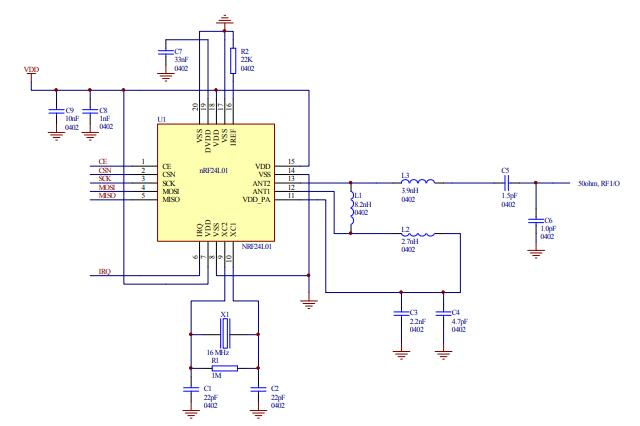
Compatibility of the NRF24L01
To connect an NRF24L01 with other Nordic chipsets like the NRF2401 series, it helps to understand the basic principles that make these devices compatible. Following these guidelines can improve communication between different models and create a smoother connection.
Transmit and Receive Settings
Getting the transmit and receive modes right is key to compatibility. Each device has specific technical requirements, so it’s important to set these modes carefully. Adjusting these settings can help reduce interference and improve data quality, making the connection stronger and more reliable.
Frequency Matching
Matching frequencies between devices is needed for clear communication. Setting the same frequency helps prevent data collisions and keeps the connection stable. By understanding each device’s frequency options, you can use techniques like frequency hopping to avoid crowded channels and maintain a clean signal.
Choosing Data Rates
Choosing the right data speed is a balance between speed and stability. Higher data rates can make communication faster, but they may not be as reliable in noisy environments. Lower data rates are more stable but slower. It’s often best to match the data rate to the specific conditions and needs of your setup. Setting up these devices well requires more than just technical knowledge, it also means considering factors. Physical obstacles, background noise, and even the angle of each device can affect performance. Testing different configurations and adjusting as needed can help you overcome these challenges and get the best results.
Package for NRF24L01
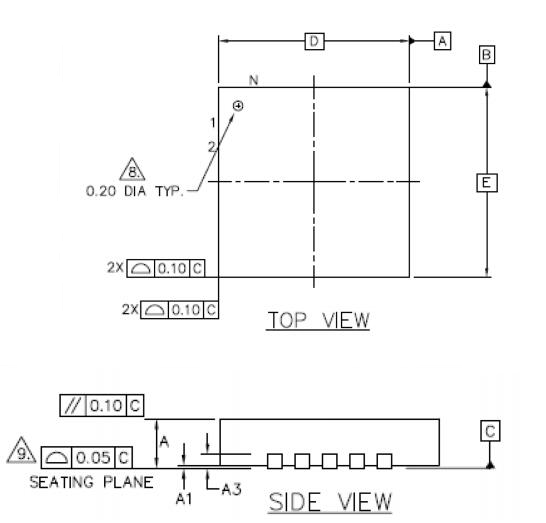
NRF24L01 Manufacturer Information
Nordic Semiconductor is celebrated for its pioneering work in ultra-low-power wireless technologies, particularly in advancing Bluetooth Low Energy (BLE) solutions. The widely recognized NRF24L01 chip stands out for its exceptional energy efficiency, setting a high standard for low-power wireless communication. This technology is utilized across a spectrum of applications, including smart home devices and IoT solutions. Their strategic development of innovative products addresses both expansive and specialized markets, reflecting their widespread impact. An insightful observation reveals Nordic Semiconductor's dedication to low-energy solutions as part of a larger industry trend towards sustainability. This shift highlights increasing awareness and adaptation to global energy conservation needs.
Datasheet PDF
NRF24L01 Datasheets:
All Devices Label Chgs 11/Feb/2020.pdf
CC2500RGP Datasheets:
SI4455-B1A-FMR Datasheets:
Labeling Change 14/Dec/2021.pdf
Mult Dev Label Chgs 20/Oct/2021.pdf
Si4355/4455 Programming Guide.pdf
SI4455-C2A-GM Datasheets:
Labeling Change 14/Dec/2021.pdf
IC/SIP MOQ Chg 11/Jan/2022.pdf
About us
ALLELCO LIMITED
Read more
Quick inquiry
Please send an inquiry, we will respond immediately.
Frequently Asked Questions [FAQ]
1. What is the difference between NRF24L01+ and NRF24L01?
The NRF24L01+ distinguishes itself by offering an additional on-air data rate of 250kbps, providing enhanced communication efficiency for environments demanding high data throughput, in contrast to the older NRF24L01, which supports only 1Mbps or 2Mbps. Both versions maintain compatibility as long as shared data rates of 1Mbps or 2Mbps are used. Selecting the "+" variant can be beneficial for scenarios involving dense signal environments where robust data transmission is desired.
2. How do I implement an NRF24l01 connection with Arduino?
Delve into the creation of wireless links between two Arduino boards using the NRF24L01 module. Engaging with this setup offers project diversity, from straightforward signal exchanges to intricate network designs with multiple devices. For newcomers to wireless communication, thorough guides and illustrative support materials can ease the learning process.
3. Where can I find an NRF24l01 library download?
The enhanced NRF24L01+ library, compatible with Arduino, ATTiny, Due, and Raspberry Pi, integrates advancements from various collaborative improvements and updates. Utilizing this resource can streamline implementation steps, boost functionalities, and address challenges faced in wireless project deployments. Harnessing community-sourced open-source repositories can noticeably decrease setup efforts and heighten project outcomes.
4. How do I design an antenna for the NRF24l01?
Elevating the reach of NRF24L01 modules often involves the imaginative crafting of antennas. For instance, expanding signal coverage through several walls can be achieved by constructing an external dipole antenna, which notably extends the operational range. Such practical issues often incite innovative solutions, urging experimentation with antenna designs to match specific signal requirements.
5. How do I fix the range for an NRF24l01?
Despite the NRF24L01+ PA/LNA module's promising specifications for wireless communication, implementation may unveil constraints. Merging tangible enhancements with insights from open-source software projects can finely tune device range capabilities. From affordable, large-scale Chinese markets often reveal how economical yet effective modules perform when used.
6. How do I hook up an NRF24l01 with a Raspberry Pi?
Explore a comprehensive walkthrough for linking the NRF24L01+ to Raspberry Pi using GPIO pins, functioning as a Serial Gateway. Such detailed guidelines facilitate the incorporation of Pi systems into wireless networks, laying the groundwork for broadened IoT applications. Contributions from the community emphasize the Raspberry Pi's flexibility in playing these roles.
7. Where can I find an NRF24l01 tutorial?
Access clear and concise tutorials on the operations of the NRF24L01 2.4GHz Transmitter Receiver, such as managing LEDs. These tutorials offer practical insights into transceiver functions, providing an ideal starting point for beginners eager to explore wireless components through detailed instructions. These educational resources highlight practical applications, fostering initial steps in computational learning.
8. What does NRF24L01 stand for?
The NRF24L01 stands out as a compact radio transceiver functioning on the 2.4 - 2.5 GHz ISM band. Its construction combines elements like a frequency synthesizer, power amplifier, crystal oscillator, and modulator/demodulator, focusing on the Enhanced ShockBurst™ protocol engine. As a versatile component, it supports a breadth of wireless communication frameworks, showcasing its all-encompassing design.

PIC16F887 8-bit Microcontroller: Datasheet, Programming, and Specifications
on November 11th
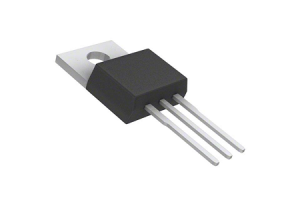
LM317AT Linear Voltage Regulators: Features and Datasheet
on November 10th
Popular Posts
-

What is GND in the circuit?
on January 1th 3145
-

RJ-45 Connector Guide: RJ-45 Connector Color Codes, Wiring Schemes, R-J45 Applications, RJ-45 Datasheets
on January 1th 2697
-

Understanding Power Supply Voltages in Electronics VCC, VDD, VEE, VSS, and GND
on November 15th 2276
-

Fiber Connector Types: SC Vs LC And LC Vs MTP
on January 1th 2195
-

Comparison Between DB9 and RS232
on January 1th 1812
-

What Is An LR44 Battery?
Electricity, that ubiquitous force, quietly permeates every aspect of our daily lives, from trivial gadgets to life-threatening medical equipment, it plays a silent role. However, truly grasping this energy, especially how to store and efficiently output it, is no easy task. It is against this background that this article will focus on a type of coin cell battery that may seem insignificant on the...on January 1th 1783
-

Understanding the Fundamentals:Inductance Resistance, andCapacitance
In the intricate dance of electrical engineering, a trio of fundamental elements takes center stage: inductance, resistance, and capacitance. Each bears unique traits that dictate the dynamic rhythms of electronic circuits. Here, we embark on a journey to decipher the complexities of these components, to uncover their distinct roles and practical uses within the vast electrical orchestra. Inductan...on January 1th 1735
-

CR2430 Battery Comprehensive Guide: Specifications, Applications and Comparison to CR2032 Batteries
What is CR2430 battery ?Benefits of CR2430 BatteriesNormCR2430 Battery ApplicationsCR2430 EquivalentCR2430 VS CR2032Battery CR2430 SizeWhat to look for when buying the CR2430 and equivalentsData Sheet PDFFrequently Asked Questions Batteries are the heart of small electronic devices. Among the many types available, coin cells play a crucial role, commonly found in calculators, remote controls, and ...on January 1th 1692
-

What Is RF and Why Do We Use It?
Radio Frequency (RF) technology is a key part of modern wireless communication, enabling data transmission over long distances without physical connections. This article delves into the basics of RF, explaining how electromagnetic radiation (EMR) makes RF communication possible. We will explore the principles of EMR, the creation and control of RF signals, and their wide-ranging uses. The article ...on January 1th 1690
-

Comprehensive guide to hFE in transistors
Transistors are crucial components in modern electronic devices, enabling signal amplification and control. This article delves into the knowledge surrounding hFE, including how to select a transistor's hFE value, how to find hFE, and the gain of different types of transistors. Through our exploration of hFE, we gain a deeper understanding of how transistors work and their role in electronic circu...on November 15th 1657



